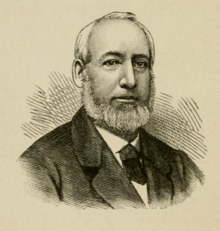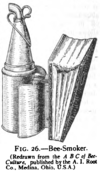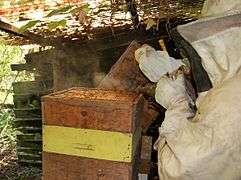Bee smoker

A bee smoker (usually called simply a smoker) is a device used in beekeeping to calm honey bees. It is designed to generate smoke from the smouldering of various fuels, hence the name.
History


Long before the invention of the bee smoker, humans had discovered that smoke calmed bees. It is not clear when this practice started but it has been used in various parts of the world where honey is collected in the wild. A camp fire can be started in near proximity to the nest, a smouldering stick or torch can be brought to the nest. It is still used today in Nepal to collect wild psychotropic honey from cliff colonies.[1]
Moses Quinby invented the modern bee smoker with a bellow attached to a tin burner in 1873 in the Mohawk Valley, New York. As part of his Quaker upbringing and belief, he did not patent any of his inventions (including the smoker) and therefore gave it to the beekeeping community.[2][3] Tracy F. Bingham of Farwell, Michigan improved and patented on January 20, 1903 (US Patent # US718689A) an improved smoker based on the design of Quinby.[4]
There are many modifications to the basic original design. Since the burner can get very hot, a safety guard against burns is often placed into the second, outer can (making the smoker double wall). Alternatively, the burner can be surrounded with a protective wire cage.
Action and usage

The fact that smoke calms bees has been known since ancient times; however, the scientific explanation was unknown until the 20th century and is still not fully understood. Smoke masks alarm pheromones[5] which include various chemicals, e.g., isopentyl acetate[6] that are released by guard bees or bees that are injured during a beekeeper's inspection. The smoke creates an opportunity for the beekeeper to open the beehive and work while the colony's defensive response is interrupted. In addition, smoke initiates a feeding response in anticipation of possible hive abandonment due to fire.[7][8][9]
Smoke is of limited use with a swarm, partly because swarms have no honey stores to feed on. It is usually not needed, either, since swarms tend to be less defensive as they have no home to defend, and a fresh swarm will have fed well at the hive it left behind.
Design and operation of a traditional smoker
Many types of fuel can be used in a smoker.[10] These fuels include hessian, burlap, pine needles, corrugated cardboard, paper egg cartons, rotten wood or herbs.[11] Some beekeeping supply sources also sell commercial fuels like pulped paper and compressed cotton.
The fuel in the smoker's burner smoulders slowly because there is only a small amount of oxygen inside, until a squeeze of the bellows provides a blast of fresh air. In this way the fuel is used more sparingly than in an open pan, and one load of fuel may last for several hours, or even days (if it is extinguished and rekindled again later). To calm the bees, the smoke must not be hot.
References
- ↑ National Geographic -The Last Death-Defying Honey Hunter of Nepal - https://www.nationalgeographic.com/magazine/2017/07/honey-hunters-bees-climbing-nepal/
- ↑ Bee Culture - Moses Quinby - http://www.beeculture.com/moses-quinby/
- ↑ Thermal Beekeeping: Look Inside a Burning Bee Smoker - https://americanbeejournal.com/thermal-beekeeping-look-inside-a-burning-bee-smoker/
- ↑ The Encyclopaedia Britannica - 11th Edition - Volumes 3-4 - page 636
- ↑ Visscher, P. Kirk; Vetter, Richard S.; Robinson, Gene E. (January 1995). "Alarm pheromone perception in honey bees is decreased by smoke (Hymenoptera: Apidae)". Journal of Insect Behavior. 8 (1): 11–18. doi:10.1007/BF01990966.
- ↑ Harris, Jeffrey W.; Woodring, Joseph (September 1999). "Effects of dietary precursors to biogenic amines on the behavioural response from groups of caged worker honey bees (Apis mellifera) to the alarm pheromone component isopentyl acetate". Physiological Entomology. pp. 285–291. doi:10.1046/j.1365-3032.1999.00141.x.
- ↑ Free, J. B. (24 March 2015). "Engorging of Honey by Worker Honeybees when their Colony is Smoked". Journal of Apicultural Research. 7 (3): 135–138. doi:10.1080/00218839.1968.11100203.
- ↑ Newton, David C. (24 March 2015). "Behavioural Response of Honeybees to Colony Disturbance by Smoke. I. Engorging Behaviour". Journal of Apicultural Research. 7 (1): 3–9. doi:10.1080/00218839.1968.11100181.
- ↑ Newton, David Comstock (1967). Behavioral Response of Honey Bees (Apis Mellifera L., Hymenoptera: Apidae) to Colony Disturbance by Smoke, Acetic Acid, Isopentyl Acetate, Light, Temperature and Vibration (Ph.D. thesis). University of Illinois at Urbana-Champaign. p. 57. No.302256408 – via ProQuest Dissertations Publishing.
- ↑ Sammataro, Diana; Avitabile, Alphonse (1998). The Beekeeper's Handbook. Cornell University Press. ISBN 0801485037.
- ↑ Modern Farmer - Bee Smoker Fuel - https://modernfarmer.com/2016/06/bee-smoker-fuel/
| Wikimedia Commons has media related to Bee smokers. |